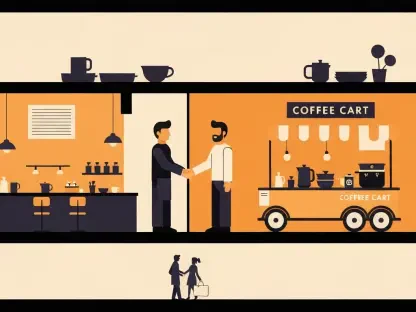Picture a bustling hotel lobby where a single glitch in the booking system delays check-ins, frustrates guests, and risks tarnishing a hard-earned reputation. In today’s hospitality industry, technology isn’t just a tool—it’s the heartbeat of operations, dictating everything from guest satisfaction to revenue streams. Hoteliers stand at a critical crossroads, forced to choose between specialized Best-in-Class systems that promise precision and comprehensive All-in-One platforms that offer simplicity. This decision shapes not just daily workflows but the very future of a property in a hyper-competitive market.
The stakes of this tech dilemma couldn’t be higher. With digital tools now central to every guest interaction and operational task, selecting the right system can mean the difference between soaring profits and costly inefficiencies. Data from a recent industry report surveying over 300 hotel professionals reveals a pressing need for clarity in this choice, as satisfaction rates and guest experiences vary widely between the two approaches. This exploration dives deep into the trade-offs, expert insights, and hard numbers to uncover which solution truly delivers for hotels aiming to thrive.
The Evolving Landscape of Hotel Technology
In an era where digital transformation drives hospitality, technology has become the backbone of seamless guest experiences and streamlined operations. From online reservations to revenue optimization, every touchpoint relies on robust systems to meet rising expectations. Yet, the pressure to balance personalization with efficiency—often on tight budgets—creates a unique challenge for hoteliers navigating an ever-expanding array of tech options.
This rapid evolution amplifies the importance of making informed decisions. Smaller properties might prioritize affordability, while larger ones seek scalability to handle complex demands. Regardless of size, the right tech stack can elevate a hotel’s brand, ensuring guests return and profits grow, while a poor choice risks operational chaos and negative reviews that spread like wildfire.
Decoding the Two Titans of Hotel Tech
At the core of the debate are two distinct approaches to hotel technology: Best-in-Class systems and All-in-One platforms. Best-in-Class tools are specialized solutions, often integrated around a central Property Management System (PMS), excelling in specific functions like revenue management or guest engagement. Industry data shows a striking 70% satisfaction rate with PMS among users of these systems, compared to just 55% for their counterparts, underscoring their precision and adaptability, especially for larger hotels with over 100 rooms.
In contrast, All-in-One platforms bundle a wide range of features into a single package from one provider, appealing to smaller properties with 100 rooms or fewer, where 54% opt for this model due to its cost-effectiveness and ease of use. However, challenges emerge with guest-facing issues—57% of users report booking errors, far exceeding the 45% among Best-in-Class users. This gap highlights a critical trade-off between simplicity and reliability that hoteliers must weigh carefully.
A notable trend shaping this landscape is the shift in preference, with 30% of All-in-One users planning to transition to Best-in-Class systems over the next couple of years, compared to only 14% moving in the opposite direction. Integration remains a persistent hurdle, cited by 38% of professionals as a major pain point, signaling that connectivity and compatibility are non-negotiable factors in any tech strategy.
Industry Voices Weigh In on the Debate
Insights from hospitality leaders shed light on the nuances of this tech tug-of-war. Vanja Bogicevic, a clinical associate professor at a leading hospitality research center, emphasizes, “Hoteliers are leaning on technology to boost both efficiency and profitability in unprecedented ways.” This perspective aligns with findings that 51% of surveyed professionals plan significant tech upgrades within the next 12 to 24 months, reflecting an urgency to stay ahead.
Jacob Messina, CEO of a prominent hotel tech firm, champions Best-in-Class systems for their “specialized functionality and flexibility,” a sentiment echoed by higher satisfaction rates—59% for revenue management tools compared to 51% for All-in-One alternatives. Meanwhile, Klaus Kohlmayr, a chief strategist at a revenue solutions company, stresses that “integrations and collaboration are the bedrock of scalable tech,” pointing to the need for cohesive ecosystems as hotels expand their digital footprints.
These expert opinions, paired with concrete data, paint a vivid picture of an industry at a turning point. While All-in-One systems retain appeal for their straightforward setup, the superior performance and adaptability of Best-in-Class tools seem to resonate more deeply with those prioritizing long-term growth and guest satisfaction.
Real-World Impacts on Guests and Operations
The choice between these systems directly affects the guest experience, often in ways that can make or break a hotel’s reputation. All-in-One platforms, while convenient, show alarming rates of guest-facing hiccups—46% of users report check-in delays, compared to just 23% for Best-in-Class systems. Such disparities can lead to frustrated travelers and negative feedback that lingers online.
Operationally, the impact is equally stark. Larger properties, with 68% favoring Best-in-Class solutions, benefit from tailored tools that handle intricate needs like dynamic pricing and detailed reporting. A mid-sized independent hotel, for instance, reported a 15% revenue uptick after switching to specialized revenue management software, illustrating the tangible gains of customization over a one-size-fits-all approach.
For smaller hotels, the allure of All-in-One systems lies in reduced upfront costs and simpler training. Yet, with only 34% of users satisfied with support and training, the risk of operational bottlenecks looms large, potentially offsetting initial savings when staff struggle to troubleshoot issues without adequate vendor backing.
Crafting a Winning Tech Strategy for Hotels
Navigating this complex decision requires a strategic approach tailored to a property’s unique needs. First, assessing scale and goals is critical—larger hotels should lean toward Best-in-Class for depth and scalability, while smaller ones might start with All-in-One for affordability, planning for future shifts as they grow. Testing systems for usability before full commitment can prevent costly missteps.
Integration capabilities must also take center stage, given the widespread connectivity challenges. Opting for platforms with open APIs or strong vendor partnerships ensures tools work in harmony, avoiding disruptions that frustrate staff and guests alike. Regularly monitoring guest-facing performance, such as minimizing booking errors or delays, further safeguards a hotel’s reputation in a digital-first world.
Looking ahead, building a flexible tech roadmap is essential. With half of the industry eyeing upgrades by 2027, hoteliers should prioritize vendors offering robust support and scalability. This forward-thinking mindset allows properties to adapt to emerging trends, ensuring technology remains an asset rather than a liability in the quest for excellence.
Reflecting on the Path Forward
Looking back, the journey through the intricacies of hotel technology revealed a clear tilt toward Best-in-Class systems, driven by their unmatched precision and adaptability in a demanding industry. All-in-One platforms, while practical for some, struggled to match the performance and satisfaction levels needed for sustained success. For hoteliers who wrestled with this choice, the path ahead became clearer by focusing on tailored solutions that prioritized guest experiences and operational efficiency.
As the hospitality sector moved forward, the emphasis shifted to actionable steps—evaluating specific needs, ensuring seamless integrations, and staying agile for future innovations. Vendors, too, faced a mandate to enhance support and connectivity, bridging gaps that once hindered progress. Ultimately, the commitment to strategic tech adoption stood as the cornerstone for properties that aimed to not just survive but excel in an ever-evolving landscape.









